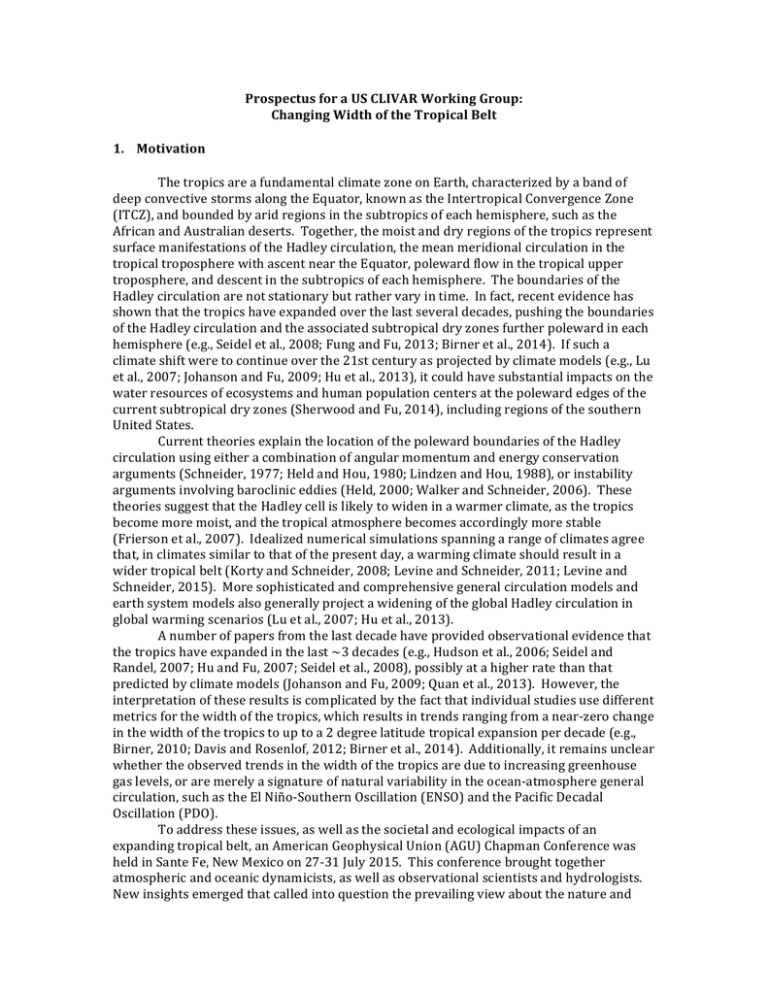Document 12848469
advertisement

ProspectusforaUSCLIVARWorkingGroup: ChangingWidthoftheTropicalBelt 1.Motivation ThetropicsareafundamentalclimatezoneonEarth,characterizedbyabandof deepconvectivestormsalongtheEquator,knownastheIntertropicalConvergenceZone (ITCZ),andboundedbyaridregionsinthesubtropicsofeachhemisphere,suchasthe AfricanandAustraliandeserts.Together,themoistanddryregionsofthetropicsrepresent surfacemanifestationsoftheHadleycirculation,themeanmeridionalcirculationinthe tropicaltropospherewithascentneartheEquator,polewardflowinthetropicalupper troposphere,anddescentinthesubtropicsofeachhemisphere.Theboundariesofthe Hadleycirculationarenotstationarybutrathervaryintime.Infact,recentevidencehas shownthatthetropicshaveexpandedoverthelastseveraldecades,pushingtheboundaries oftheHadleycirculationandtheassociatedsubtropicaldryzonesfurtherpolewardineach hemisphere(e.g.,Seideletal.,2008;FungandFu,2013;Birneretal.,2014).Ifsucha climateshiftweretocontinueoverthe21stcenturyasprojectedbyclimatemodels(e.g.,Lu etal.,2007;JohansonandFu,2009;Huetal.,2013),itcouldhavesubstantialimpactsonthe waterresourcesofecosystemsandhumanpopulationcentersatthepolewardedgesofthe currentsubtropicaldryzones(SherwoodandFu,2014),includingregionsofthesouthern UnitedStates. CurrenttheoriesexplainthelocationofthepolewardboundariesoftheHadley circulationusingeitheracombinationofangularmomentumandenergyconservation arguments(Schneider,1977;HeldandHou,1980;LindzenandHou,1988),orinstability argumentsinvolvingbarocliniceddies(Held,2000;WalkerandSchneider,2006).These theoriessuggestthattheHadleycellislikelytowideninawarmerclimate,asthetropics becomemoremoist,andthetropicalatmospherebecomesaccordinglymorestable (Friersonetal.,2007).Idealizednumericalsimulationsspanningarangeofclimatesagree that,inclimatessimilartothatofthepresentday,awarmingclimateshouldresultina widertropicalbelt(KortyandSchneider,2008;LevineandSchneider,2011;Levineand Schneider,2015).Moresophisticatedandcomprehensivegeneralcirculationmodelsand earthsystemmodelsalsogenerallyprojectawideningoftheglobalHadleycirculationin globalwarmingscenarios(Luetal.,2007;Huetal.,2013). Anumberofpapersfromthelastdecadehaveprovidedobservationalevidencethat thetropicshaveexpandedinthelast~3decades(e.g.,Hudsonetal.,2006;Seideland Randel,2007;HuandFu,2007;Seideletal.,2008),possiblyatahigherratethanthat predictedbyclimatemodels(JohansonandFu,2009;Quanetal.,2013).However,the interpretationoftheseresultsiscomplicatedbythefactthatindividualstudiesusedifferent metricsforthewidthofthetropics,whichresultsintrendsrangingfromanear-zerochange inthewidthofthetropicstouptoa2degreelatitudetropicalexpansionperdecade(e.g., Birner,2010;DavisandRosenlof,2012;Birneretal.,2014).Additionally,itremainsunclear whethertheobservedtrendsinthewidthofthetropicsareduetoincreasinggreenhouse gaslevels,oraremerelyasignatureofnaturalvariabilityintheocean-atmospheregeneral circulation,suchastheElNiño-SouthernOscillation(ENSO)andthePacificDecadal Oscillation(PDO). Toaddresstheseissues,aswellasthesocietalandecologicalimpactsofan expandingtropicalbelt,anAmericanGeophysicalUnion(AGU)ChapmanConferencewas heldinSanteFe,NewMexicoon27-31July2015.Thisconferencebroughttogether atmosphericandoceanicdynamicists,aswellasobservationalscientistsandhydrologists. Newinsightsemergedthatcalledintoquestiontheprevailingviewaboutthenatureand causesofchangesinthewidthofthetropics.Keyconclusionsofthismeeting(inour interpretation)wereasfollows: ·Recentobservedestimatesoftheexpansionofthetropicsvarywidely,rangingfrom 0.25to3degreeslatitudeperdecade(DavisandRosenlof,2012),dependingonthetime period,theinstrumentordataset,andthemetricusedtomeasureedgeofthetropics(Davis andBirner,2013;Lucasetal.,2014).Thesheernumberofmetricsisnotable.Itwas recommendedthatagroupbeconvenedtowriteapeer-reviewedjournalarticleto documentwhateachmetricphysicallyrepresentsabouttheedgeofthetropics,toexplore howthemetricsrelatetooneanother,andtorecommendasmallersubsetofmetricstobe used,consistentlyandreproducibly,infuturestudies. ·Thecausesofvariabilityinthewidthofthetropicsondecadaltimescalesremainhighly uncertain.Priortothismeeting,theprevailingviewpointwasthatrecentvariabilityinthe widthofthetropicswasthedirectresultofanthropogenicforcing.Whiletherolesof stratosphericozonedepletionintheSouthernHemisphere(Waughetal.,2015)and aerosolsintheNorthernHemisphere(Allenetal.,2014)werenoted,theoverallconsensus ofthismeetingwasthatnaturalvariabilitydominatedtropicalwideningoverthepast severaldecades,primarilythroughmodesofcoupledatmosphere-oceanvariabilitysuchas ENSO(Monteiroetal.,2015)orthePDO(Allenetal.,2014).Asaresultofthisshiftin viewpoint,futureresearchwasrecommendedtoaddresstheroleofcoupledatmosphereoceanvariabilityinthewidthofthetropicalbelt,andhowchangesintheHadleycirculation mightfeedbackonthegeneralcirculationoftheocean. ·ResultsfromCook(2003),KarnauskasandUmmenhofer(2014),andLucasandNguyen (2015)havecalledintoquestionthemeritofexaminingthetraditionalzonal-meanviewof theHadleycirculationforlocalimpacts.KarnauskasandUmmenhofer(2014)noted,for example,thataHadleycell-likeoverturningcirculationisnottypicallypresentatall longitudesinthetropics,butratherisconfinedtolongitudebandsineasternsubtropical oceanbasins,wheretherearelargeland-seatemperaturecontrasts.Itremainsunclear whethertherecentobservedwideningofthetropicsisfocusedintheseparticularlongitude bands,orismoreglobalinitsextent.Itwasrecommendedthatabetterconnectionbe madebetweenthezonal-meanexpansionoftheHadleycirculationandchangesinthe regionalcirculationsofthetropicalandsubtropicalzones. 2. Objectives,Tasks,Timeline ToimplementtherecommendationsfromtherecentAGUChapmanconference,wepropose toestablishathree-yearUSCLIVARWorkingGroupontheChangingWidthoftheTropical Belt.Theobjectivesfortheproposedworkinggroupareasfollows: Objective#1:Provideguidanceonwhichmetricsaremostappropriatetoquantifykey impactsofthechangingwidthofthetropicalbelt.Todothis,wewillassessandsynthesize knowledgefromnumerousstudiesthathaveuseddifferentmetrics,timeperiods,and modelforcingscenariostodocumenttheexpansionofthetropics.Ourrationaleforthis objectivearisesfromthelackofconsensusachievedduringdiscussionsattheChapman Conference.Weexpectthataselectionofstandardoraccepteddefinitionsandmetricsmay assistinthecommunicationoftropicalwidthchangestothebroaderscientificcommunity. ThisobjectivedirectlyaddressestheUSCLIVARsciencegoalto“betterquantifyuncertainty intheobservations,simulations,predictions,andprojectionsofclimatevariabilityand change”,andthemissionoftheUSCLIVARPOSpanelto“developsynthesesofcritical climateparameters.” Objective#2:Identifyhowanthropogenicforcingandnaturalatmosphere-oceanvariability contributeuniquelytodecadaltimescalechangesinthewidthofthetropicalbelt.Akey themeoftherecentChapmanConferencewasthedifficultyofseparatingtherolesof naturalvariability(particularlyfromcoupledatmosphere-oceanvariability,suchasENSO andthePDO)andanthropogenicforcinginrecenttrendsinthewidthofthetropicalbelt. Kangetal.(2013)havepreviouslyidentifiedcoupledatmosphere-oceanvariabilityasakey sourceofuncertaintyinfuturetropicalcirculationtrends.Furthermore,thetropical oceanicoverturningcirculationisintegrallylinkedwiththeatmosphericHadleycirculation (Clement,2006),asthecirculationsmirroreachotherthroughanEkmanforcebalance (Schneideretal.,2014).Understandingtheinterplaybetweenatmosphere-oceancoupling andthevaryingwidthofthetropicsrequiresajointteamofatmosphericscientistsand oceanographerstoprovidenovelinsightsintopastobservedclimatevariabilityandfuture climatemodelprojections.ThisobjectivedirectlyaddressestheUSCLIVARsciencegoalsto 1)“understandtheroleoftheoceansinobservedclimatevariabilityondifferent timescales”and2)“improvethedevelopmentandevaluationofclimatesimulationsand predictions.”ThisobjectivealsoservesthemissionoftheUSCLIVARPSMIpanelto“reduce uncertaintiesinthegeneralcirculationmodelsusedforclimatevariabilitypredictionand climatechangeprojectionsthroughanimprovedunderstandingandrepresentationofthe physicalprocessesgoverningclimateanditsvariation.”Finally,thisobjectiveisdirectly relevanttotheUSCLIVARResearchChallengeconcerningdecadalvariabilityand predictability. Objective#3:Addresshowtheglobal-scalewideningofthetropicsismanifestedthrough regional-scaleimpacts.DuringtherecentChapmanConference,ageneralconsensuswas reachedthattheimpactsofclimatevariabilityandchangeareexperiencedlocally,butit wasnotgenerallyagreedthatthetraditionalzonal-meanviewoftheHadleycirculationwas atallmeaningfulintermsofimpacts.Understandingtherelevanceofglobal-scaleHadley circulationchangestoregional-scaleimpactsinthesubtropicsiscriticaltocommunicating theimpactsoftheexpandingtropicstopolicymakers.Thisobjectivedirectlyaddressesthe USCLIVARsciencegoalto“understandtheprocessesthatcontributetoclimatevariability andchangeinthepast,present,andfuture,”andthemissionoftheUSCLIVARPOSpanelto “improveunderstandingofclimatevariationsinthepast,present,andfuture.”This objectivealsoservesthemissionoftheUSCLIVARPPAIpanel,withitsfocusonpredictions andinterfacingwiththeapplications,operations,anddecision-makingcommunity. Objective#4:Coordinateeffortwithotherinternationalprograms(e.g.,SPARCDynVar, WCRPGrandChallengeonClouds,Circulation,andClimateSensitivity,GEWEX HydroclimatologyPanel),andinformfundingagenciesofwhereresearchinitiativesare neededtoadvanceunderstanding.Werecognizethattheproposedworkinggroupisoneof manygroupswithstronginterestinpastandfuturechangesinthetropicalatmospheric andoceanicgeneralcirculation,andthatoureffortswillbemosteffectiveinasmuchasthey leverageinterconnectionswithexistingresearchcommunities.Assuch,wehavesuggested membersofthisworkinggroupwithadiverserangeofexpertise,tohelpbuildbridges acrossdistinctresearchcommunitiesinterestedintheimpactsofglobal-scaletropical circulationchanges.ThisobjectivedirectlyaddressestheUSCLIVARsciencegoalto “collaboratewithresearchandoperationalcommunitiesthatdevelopanduseclimate information,”andthemissionoftheUSCLIVARPPAIpanelto“fosterimprovedpracticesin theprovision,validationandusesofclimateinformationandforecaststhroughcoordinated participationwithintheU.S.andinternationalclimatescienceandapplications communities.” Toaccomplishtheaboveobjectives,theworkinggroupwillcompletethefollowingtasks: 1)Publishapeer-reviewedjournalarticletoprovidethecommunitywitha comprehensiveassessmentoftropicalwidthmetricsandtorecommendasubsetof metricstobeusedbysubsequentstudies(tobetteraidincomparisonamong studiesacrossthepublishedliterature). 2)Compareandcontrasttheimpactsofanthropogenicforcingandcoupled atmosphere-oceanvariabilityondecadalvariabilityintropicalwidth.Synthesize ourunderstandingofcouplingbetweentropicalwidthandseasurface temperatures. 3)Informlinkagesbetweenglobal-scalecirculationchangesandtheregional-scale circulationchangesmostrelevantforimpacts,settingthestageforasessionatthe AGUFallMeetingonglobalandregionalimpactsoftropicalcirculationchange. Thetaskswillbecompletedaccordingtothefollowingtimeline: ● Year1:Planandscheduleworkinggroupactivities,reviewpreviousresearch,and identifystrategiesforworkinggroupresearchinitiatives. ● Year2:Research,assessandsynthesizeresearchfindings,andbegintodraftpeerreviewedjournalarticlestosummarizeworkinggroupfindings. ● Year3:Finalizeresearchandjournalarticles,holdsessionatAGUFallMeeting, reportresultstoCLIVAR,andproposefuturework. 3.PublicationsandOutreach Thepublicationsresultingfromtheactivitiesoftheproposedworkinggroupwillinclude: 1)Apaperthatprovidesacomprehensiveassessmentoftropicalwidthmetricsandthat recommendsasubsetofmetricstobeusedbysubsequentstudies 2)Apaperthatreviewshowvarioustypesofcoupledatmosphere-oceanvariabilityare linkedtothewidthofthetropicalbelt 3)Apaperthatinvestigateslinkagesbetweenglobal-scaletropicalcirculationchangesand regional-scaleimpacts(summarizingtheresultsoftheAGUsessionheldonthistopic) TheoutreachoftheworkinggroupwillincludepresentationstoUSCLIVAR,articlesinthe USCLIVARVariationsnewsletter,andspecialsessionsattheAGUorAmerican MeteorologicalSocietyannualmeetings. 4.ReportingPlan Aslistedabove,theobjectivesoftheproposedworkinggrouparehighlyrelevanttothe sciencegoalsofUSCLIVAR,aswellastothemissionsofthethreeUSCLIVARpanels(POS, PSMI,andPPAI).SeveralmembersofthePSMIpanelrecommendedtheideaforthis workinggroup,andweproposetoreportourprogresstoboththePOSandPSMIpanelsand seektheiradviceandsupport.WealsoproposetoreportonourprogressattheannualUS CLIVARsummitandpanelmeetings,asappropriate. 5.LeadershipandSuggestedMembership PaulStaten(IndianaUniversity)andKevinGrise(UniversityofVirginia)willserveascochairsoftheproposedworkinggroupandwereresponsibleforthedevelopmentofthis prospectus.Theco-chairshaveexpertiseinatmosphericandclimatedynamics,anduse bothobservationsandglobalclimatemodelexperimentstounderstandtheatmospheric generalcirculation,itsvariability,anditsresponsetoanthropogenicforcing. Weproposetohaveaworkinggroupmembershipwithdiverseexpertise,including memberswithspecialtiesinatmosphericdynamics,oceandynamics,atmosphere-ocean interaction,globalclimate,regionalclimate,monsoons,observationalanalysis,andclimate modeling.Wealsoproposeahealthymixofscientistsatdifferentcareerstages,to maximizecommunityinvolvementandnetworking/mentoringopportunities.Suggested membersalongwiththeiraffiliationsandareasofexpertisearelistedbelow: ● ● ● ● ● ● ● ● ● ● ● ● ● ● ● ● ● ● ● *OriAdam(ETHZurich):Energeticconstraintsofthetropicalcirculation RobertAllen(California-Riverside):Aerosolsandoceanicvariability ThomasBirner(ColoradoState):Troposphere-stratosphereinteractions GangChen(UCLA):Atmosphericdynamics,regionalimpacts KerryCook(UniversityofTexas):Regionalclimatechangeimpacts SeanDavis(NOAA):Stratosphericozoneandwatervaporvariability QiangFu(UniversityofWashington):Remotesensingandradiativetransfer KevinGrise(UniversityofVirginia):Atmosphericcirculationvariabilityandchange KristopherKarnauskas(Univ.ofColorado):SimulatedregionalHadleycirculations *JamesKossin(NOAA,Univ.ofWisconsin):Hurricanesandclimatevariability *ChrisLucas(BureauofMeteorology,Australia):Tropicalwidthobservations *AmandaMaycock(UniversityofLeeds):Troposphere-stratosphereinteractions, chemistrycoupling *TimothyMerlis(McGillUniversity):Ocean-atmospheregeneralcirculation,tropical meteorology *Xiao-WeiQuan(Univ.ofColorado,NOAA):Rainfallvariabilityandhydrological impacts *KarenRosenlof(NOAA):Stratosphericdynamicsandcomposition IslaSimpson(NCAR):Linkageofglobal-scaleandregional-scaleclimatechange PaulStaten(IndianaUniversity):Atmosphericdynamics CarolineUmmenhofer(WoodsHole):Rainfallvariabilityandhydrologicalimpacts DarrynWaugh(JohnsHopkins):Circulationwideningandstratosphericozone *Indicatesacontributingmember 6.ResourceRequirements Theproposedworkinggroupwillmeetonceperyearfor2-3daysandwillholdmonthly teleconferences.Specifically,werequestfundingfor: -Travelsupportfortwoannualworkinggroupmeetings -Publicationchargesforthethreejournalarticlesdetailedabove References AllenR.J.,J.R.Norris,andM.Kovilakam,2014:Influenceofanthropogenicaerosolsandthe PacificDecadalOscillationontropicalbeltwidth.NatureGeosci.,7,270–274, doi:10.1038/ngeo2091. Birner,T.,S.M.Davis,andD.J.Seidel,2014:ThechangingwidthofEarth’stropical belt.PhysicsToday,67,38-44,doi:10.1063/PT.3.2620. Birner,T.,2010:Recentwideningofthetropicalbeltfromglobaltropopausestatistics: Sensitivities.J.Geophys.Res.Atmos,115,D23109,doi:10.1029/2010JD014664. Clement,A.C.,2006:TheRoleoftheOceanintheSeasonalCycleoftheHadleyCirculation.J. Atmos.Sci.,63,3351–3365,doi:http://dx.doi.org/10.1175/JAS3811.1 Cook,K.H.,2003:RoleofContinentsinDrivingtheHadleyCells.J.Atmos.Sci.,60,957–976, doi:10.1175/1520-0469(2003)060<0957:ROCIDT>2.0.CO;2. Davis,N.A.,T.Birner,2013:Seasonaltomulti-decadalvariabilityofthewidthofthetropical belt.J.Geophys.Res.,118,doi:10.1002/jgrd.50610,2013. Davis,S.M.,andK.H.Rosenlof,2012:Amultidiagnosticintercomparisonoftropical-width timeseriesusingreanalysesandsatelliteobservations.J.Climate,25,1061–1078, doi:10.1175/JCLI-D-11-00127.1. Feng,S.,andQ.Fu,2013:Expansionofglobaldrylandsunderawarmingclimate,Atmos. Chem.Phys.,13,10081-10094,doi:10.5194/acp-13-10081-2013. Frierson,D.M.W.,J.Lu,andG.Chen,2007:WidthoftheHadleycellinsimpleand comprehensivegeneralcirculationmodels.Geophys.Res.Lett.,34,L18804, doi:10.1029/2007GL031115. Held,I.M.,2000:Thegeneralcirculationoftheatmosphere.GeophysicalFluid DynamicsProgram,WoodsHoleOceanographicInstitute,70pp. Held,I.M.,andA.Y.Hou,1980:Nonlinearaxiallysymmetriccirculationsinanearly inviscidatmosphere.J.Atmos.Sci.,37,515–533,doi:10.1175/15200469(1980)037<0515:NASCIA>2.0.CO;2. Hu,Y.,L.Tao,andJ.Liu,2013:PolewardexpansionoftheHadleycirculationin CMIP5simulations.Adv.Atmos.Sci.,30,790–795,10.1007/s00376-012-2187-4. Hu,Y.,andQ.Fu,2007:ObservedpolewardexpansionoftheHadleycirculationsince1979. Atmos.Chem.Phys.,7,5229-5236,doi:10.5194/acp-7-5229-2007. Hudson,R.D.,M.F.Andrade,M.B.Follette,andA.D.Frolov,2006:Thetotalozonefield separatedintometeorologicalregimes–PartII:NorthernHemispheremid-latitudetotal ozonetrends.Atmos.Chem.Phys.,6,5183–5191,doi:10.5194/acp-6-5183-2006. Johanson,C.M.,andQ.Fu,2009:Hadleycellwidening:Modelsimulationsversus observations.J.Climate,22,2713–2725,doi:10.1175/2008JCLI2620.1. Kang,S.M.,C.Deser,andL.M.Polvani,2013:Uncertaintyinclimatechangeprojectionsof theHadleycirculation:Theroleofinternalvariability.J.Climate,26,7541–7554,doi: 10.1175/JCLI-D-12-00788.1. Karnauskas,K.B.,andC.C.Ummenhofer,2014:OnthedynamicsoftheHadleycirculation andsubtropicaldrying.ClimateDyn.,42,2259-2269,doi:10.1007/s00382-014-2129-1. Korty,R.L.,andT.Schneider,2008:ExtentofHadleycirculationsindryatmospheres. Geophys.Res.Lett.,35,L23803,doi:10.1029/2008GL035847. Levine,X.J.,andT.Schneider,2015:BarocliniceddiesandtheextentoftheHadley circulation:AnidealizedGCMstudy.J.Atmos.Sci.,72,2744-2761,doi:10.1175/JAS-D-140152.1. Levine,X.J.,andT.Schneider,2011:ResponseoftheHadleycirculationtoclimatechangein anaquaplanetGCMcoupledtoasimplerepresentationofoceanheattransport.J.Atmos. Sci.,68,769-783,doi:10.1175/2010JAS3553.1. Lindzen,R.S.,andA.Y.Hou,1988:HadleyCirculationsforZonallyAveragedHeating CenteredOfftheEquator.J.Atmos.Sci,45,2416-2427,10.1175/15200469(1988)045<2416:HCFZAH>2.0.CO;2. Lu,J.,G.A.Vecchi,andT.Reichler,2007:ExpansionoftheHadleycellunderglobalwarming. Geophys.Res.Lett.,34,L06805,doi:10.1029/2006GL028443. Lucas,C.,andH.Nguyen,2015:Regionalcharacteristicsoftropicalexpansionandtheroleof climatevariability.J.Geophys.Res.Atmos.,120,6809-6824. Lucas,C.,B.Timbal,andH.Nguyen,2014:Theexpandingtropics:acriticalassessmentof theobservationalandmodelingstudies,WIREsClimChange,5,89-112, doi:10.1002/wcc.251. Monteiro,J.,J.M.Wallace,J.Sukhatme,andR.G.Murtugudde,2015:Thecontributionof ENSOvariabilitytotherecentexpansionofthetropicalbelt.PresentedatAGUChapman ConferenceonTheWidthoftheTropics:ClimateVariationsandTheirImpacts.July29,2015. Quan,X.-W.,M.P.Hoerling,J.Perlwitz,H.F.Diaz,andT.Xu,2014:HowFastAretheTropics Expanding?,J.Climate,27,1999–2013,doi:http://dx.doi.org/10.1175/JCLI-D-13-00287.1. Schneider,E.K.,1977:Axiallysymmetricsteady-statemodelsofthebasicstatefor instabilityandclimatestudies.PartII.Nonlinearcalculations.J.Atmos.Sci.,34,280–296, doi:10.1175/1520-0469(1977)034<0280:ASSSMO>2.0.CO;2. Schneider,T.,T.Bischoff,andG.H.Haug,2014:MigrationsanddynamicsoftheIntertropical ConvergenceZone.Nature,513,45-53,doi:10.1038/nature13636. Seidel,D.J.,Q.Fu,W.J.Randel,andT.J.Reichler,2008:Wideningofthetropicalbelt inachangingclimate.Nat.Geosci.,1,21–24,doi:10.1038/ngeo.2007.38. Seidel,D.J.,andW.J.Randel,2007:Recentwideningofthetropicalbelt:Evidencefrom tropopauseobservations.J.Geophys.Res.,112,D20113,doi:10.1029/2007JD008861. Sherwood,S.,andQ.Fu,2014:,ADrierFuture?,Science,343,737-739, doi:10.1126/science.1247620. Walker,C.C.,andT.Schneider2006:EddyinfluencesonHadleycirculations:Simulations withanidealizedGCM.J.Atmos.Sci.,63,3333-3350,doi:10.1175/JAS3821.1. Waugh,D.W.,C.I.Garfinkel,andL.M.Polvani,2015:Driversoftherecenttropical expansionintheSouthernHemisphere:ChangingSSTsorozonedepletion?J.Climate,in press.






